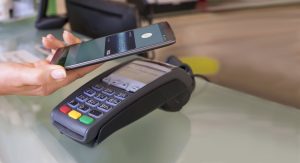A survey of more than 3,000 consumers in the United States, United Kingdom, and Australia, sponsored by Transaction Network Services, shows the heaviest adoption of mobile-payment apps in the U.S., at 59% of respondents, but the highest adoption of contactless payments in the U.K., at 79%.
Perhaps not surprisingly, younger consumers were more likely to use a mobile-payment app on a smart phone. Of those 16 to 24 years old, 71% said they would, as did 73% of those 25 to 34 years old. The likelihood begins to fall with 59% for 35-to-44 year old consumers, and drops to 42% for the 45-to-54 group and 28% for the 55-to-64 segment.
Reston, Va.-based TNS says the greatest adopters in the United States and Australia are in the 25-to-34 group. Indeed 82% of this group in the U.S. said they were likely to use a mobile-payment app. That compares to 73% in Australia and 65% in the U.K.

The report also found that more U.S. consumers—47%—were a bit more willing to make a payment using a wearable device than were those in Australia and the United Kingdom, at 42% each.
“Globally 48% of men would be willing to make a payment using a wearable device compared to 39% of women,” the report notes. “Willingness was also greatest in the younger age groups, potentially setting the stage for strong future growth over the coming decades.”
Yet, a persistent concern about security plagues potential wearable uses. Sixty-four percent of U.S. consumers said these concerns would keep them from using a wearable device to make a payment. That compares to 68% in Australia and 63% in the U.K.
“Living in the era of the cybercriminal and regular news reports concerning data breaches, it is not surprising to find that consumers exhibit security fears related to wearables,” the report adds. “While no unscrupulous activity related to payments made via wearable devices has yet been exposed at the time this report goes to press, the growth of this promising market segment could be irrevocably damaged if fraud was to occur.”
Of those who own a smart watch with payments capabilities, 47% of U.S. consumers have used it to make a payment, the highest of the three nations. Again, younger consumers are more likely to make this type of transaction than older ones, with 50% of 25-to 34-year olds having done so, compared with 22% of 55-to-64 year old individuals.
Some 79% of U.K. consumers have made at least one contactless payment a week, and 75% of Australians have done so. In the U.S., however, only 60% have done so, but a planned conversion of EMV chip cards to dual-interface versions, which would enable contactless transactions, is under way.





